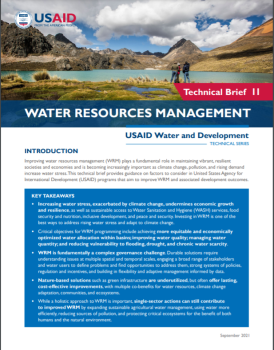Summary
This brief is part of USAID 's Water and Development Technical Series, which provides guidance on important topics for developing and implementing water and sanitation activities in support of the U.S. Government Global Water Strategy and USAID’s plan under the strategy.
Improving water resources management (WRM) plays a fundamental role in maintaining vibrant, resilient societies and economies and is becoming increasingly important as climate change, pollution, and rising demand increase water stress. This technical brief provides guidance on factors to consider in United States Agency for International Development (USAID) programs that aim to improve WRM and associated development outcomes.
KEY TAKEAWAYS
- Increasing water stress, exacerbated by climate change, undermines economic growth and resilience, as well as sustainable access to Water Sanitation and Hygiene (WASH) services, food security and nutrition, inclusive development, and peace and security. Investing in WRM is one of the best ways to address rising water stress and adapt to climate change.
- Critical objectives for WRM programming include achieving more equitable and economically optimized water allocation within basins; improving water quality; managing water quantity; and reducing vulnerability to flooding, drought, and chronic water scarcity.
- WRM is fundamentally a complex governance challenge. Durable solutions require understanding issues at multiple spatial and temporal scales, engaging a broad range of stakeholders and water users to define problems and find opportunities to address them, strong systems of policies, regulation and incentives, and building in flexibility and adaptive management informed by data.
- Nature-based solutions such as green infrastructure are underutilized, but often offer lasting, cost-effective improvements, with multiple co-benefits for water resources, climate change adaptation, communities, and ecosystems.


